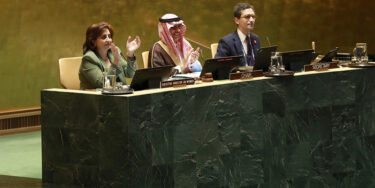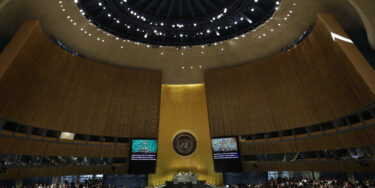In 2012 and 2013, thousands of people demonstrated against same-sex marriage in Paris and other French cities. The success of these protests came as a surprise in a country often associated with secularism and sexual freedom.
The organisation La Manif pour Tous led some of the demonstrations, taking to the streets with pink and blue flags. It urged activists abroad to emulate the French with slogans, posters and strategies travelling across borders. While similar mobilisations happened earlier in Spain, Italy, Croatia and Slovenia, 2012 appears to have been a turning point.
Spectacular mobilisations have also taken place in Latin America, which is both a key target and a production hub of anti-gender campaigns. A first flare was registered in 2011 in Paraguay, when the term ‘gender’ was contested by the Catholic right during discussions on the national education plan. In 2013, in one of his weekly TV programmes, Ecuador’s leftist president Rafael Corrêa similarly denounced ‘gender ideology’ as an instrument aimed at destroying the family. Since 2014, these attacks have intensified, with massive demonstrations in numerous countries, and they decisively impacted the Colombian peace agreement referendum in 2016.
It culminated in November 2017, when American philosopher and gender theorist Judith Butler was viciously attacked in Sao Paolo, Brazil. Although the attack received global attention, it is only the tip of the iceberg in Latin America.
Transnational campaigns
In both regions, these movements contest what they call gender ideology. Sometimes referred to as gender theory or genderism, it is presented as the matrix of the combatted policy reforms, and should therefore not be confused with gender studies or specific equality policies. No less importantly, gender ideology is seen by some as the cover for a totalitarian plan by radical feminists, LGBTQI activists and gender scholars to seize political power.
Numerous scholars have traced the origins of gender ideology back to the Vatican and their political allies.
Crucially, this discourse recaptures and reframes Cold War Catholic discourses against Marxism and stirs anti-communist sentiments in Eastern Europe as well as in Latin America. There, the ‘evils of gender’ are entangled by right-wing activists with the ‘spectres of Venezuela’ or calls for a military intervention. Although national triggers vary (abortion and reproductive rights, same-sex marriage, LGBTI parental rights, gender mainstreaming, gender violence, sex education, anti-discrimination policies and so on), the explanation given by anti-gender campaigners is always the same: all this is due to gender ideology.
These movements not only share a common enemy, they display similar discourses and strategies as well as a distinctive style of action. We label them transnational anti-gender campaigns to emphasise their global scope and underline their particular profile in the wider landscape of opposition to feminism and LGBTI rights.
A Catholic cradle
Numerous scholars have traced the origins of gender ideology back to the Vatican and their political allies. Building on previous projects such as Pope John-Paul II’s Theology of the Body lectures or the New Evangelization, it was designed in response to the 1994 Conference on Population and Development in Cairo and the 1995 World Conference on Women in Beijing, when the term ‘gender’ entered the United Nations vocabulary, surrounded by demands for rights relating to reproduction and sexuality.
This discourse, which relies on ideas espoused by Cardinal Ratzinger in the early 1980s, was developed in Europe and Latin America in the late 1990s and early 2000s, leading to the Lexicon: Ambiguous and Debatable Terms Regarding Family Life and Ethical Questions (2003) and the Letter to the Bishops of the Catholic Church on the Collaboration of Men and Women in the Church and World (2004).
Gender ideology is not only a lens through which to analyse what happened at the UN, but also a Catholic strategy of action. Based on philosopher and politician Antonio Gramsci’s theory of cultural hegemony, it propagates its alternative interpretation of gender through means that subvert the notions it opposes. While John-Paul II and Benedict XVI designed this project, Pope Francis has repeatedly expressed his support, describing gender as a form of ‘ideological colonisation’.
Campaigns on the ground
Contemporary mobilisations, however, cannot be reduced to a Catholic enterprise, but intersect with other political projects and wider sets of actors. First, present strategies are reminiscent of the US Christian Right, and US organisations are active across continents, propelling transnational networks such as the World Congress of Families.
Since evangelical voices, which are new in Latin America, are more strident, the intellectual role of the Catholic hierarchy is often overlooked.
Second, while the Vatican has been instrumental in elaborating a frame of action, actors on the ground are more diverse. They include other religious groups as well as secular voices, and form coalitions that vary considerably according to local contexts.
The European situation cannot not be understood without looking at intersections with right-wing populisms. Both rely on attacks against corrupt elites and pretend to defend ‘innocent children’. They invoke common sense against decadent ideas and claim that things have ‘gone too far’, depicting themselves as the defenders of a majority silenced by powerful lobbies. These encounters explain why, in several European countries, right-wing populists have joined anti-gender campaigns without being particularly religious. This overlap offers a springboard to anti-genderists while fuelling anti-liberal discourses and sentiments.
Campaigns in Russia and the parts of Europe under Russian influence have been directly engineered from the Kremlin with the support of the Russian Orthodox church. As part of the state machinery, they are instrumentalised to restore the international status of Russia through a global defence of national sovereignty and ‘traditional values’. Poland and Hungary are currently following this path, with Hungary’s prime minister, Victor Orban, increasingly vocal on the issue.
Latin America campaigns displays distinctive features. First, more than anywhere else, the criticism of gender ideology is no monopoly of the right, even though right-wingers are usually on the front lines. Second, these campaigns involve both conservative Catholics and evangelicals (mostly neo-Pentecostals). Since evangelical voices, which are new in the region, are more strident, the intellectual role of the Catholic hierarchy is often overlooked. However, Latin American Catholics have significantly contributed to the development of the anti-gender discourse and current anti-gender formations rely on older Catholic anti-abortion structures.
Third, anti-gender political formations are not exclusively religious but encompass secular actors whose profile differs substantially across countries. In Brazil, they include politicians playing electoral games, extreme-right actors, centre-liberals articulating anti-state arguments alongside anti-gender arguments, middle-class activists longing for social order and transnationally connected Jewish right-wing activists.
Indeed, if anti-gender campaigns are so efficient, it is precisely because they amalgamate actors who would not usually work together.
Despite this unexpected diversity, however, the populist analytical frame, so common in Europe and the US, is inappropriate. Indeed, populist practices have long been deeply ingrained in the regional political culture. As a result, populism has no side and cannot be easily mapped on to the left-right divide in the region.
A complex constellation
Anti-gender movements include a complex constellation of actors that goes far beyond specific religious affiliations. Research has shown that ‘gender ideology’ is an empty signifier, which can tap into different fears and anxieties in specific contexts and therefore be shaped to fit distinct political projects. Furthermore, as stressed by Andrea Peto, Eszter Kováts, Maari Põim and Weronika Grzebalska, the vague notion of gender ideology operates as a ‘symbolic glue’ that facilitates cooperation between actors despite their divergences.
This is precisely what must be understood: what are the specific constellations of actors in each context and how can different sorts of actors, who usually do not work together and can even compete with each other, find a common ground on which to collaborate?
In brief, how to explain joint ventures between believers and atheists, Catholic and Russian Orthodox or Latin American evangelical, or opposed strands within contemporary Roman Catholicism? It must also be reiterated that the debate is not about faith against atheism, and that not all believers of a specific denomination are involved in these campaigns.
A more sophisticated analytical frame would allow us to move away from simplistic grids such as populism, the global right or a global backlash, and pay more attention to the specific political formations at play on the ground. It would also avoid narrow binary frames opposing ‘us’ to ‘them’ that unduly homogenise distinctive contextual conditions and a complex array of forces and actors.
Finally, contextualisation and complexification are not only needed analytically, but are politically essential. Indeed, if anti-gender campaigns are so efficient, it is precisely because they amalgamate actors who would not usually work together. Today, it is crucial to further understand how these mysterious coalitions are forged and sustained.



